Anti-Pyretic, Analgesic, and Anti-Inflammatory Activities of Meloxicam and Curcumin Co-Encapsulated PLGA Nanoparticles in Acute Experimental Models
Abstract
1. Introduction
2. Materials and Methods
2.1. Chemicals
2.2. Preparation and Purification of Nanoparticles
2.3. Experimental Animals
2.4. Acute Toxicity Test
2.5. Dose Selection for In Vivo Studies
2.6. Yeast-Induced Pyrexia Model
2.7. Formalin-Induced Pain Model
2.8. Heat-Induced Nociception Model
2.9. Xylene-Induced Ear Edema Model
2.10. Carrageenan-Induced Paw Inflammation Model
2.10.1. Blood and Organ Sampling
2.10.2. Determination of TNF-α and PGE2 Levels
2.10.3. Gene Expression Analysis (qRT-PCR)
2.10.4. Histopathological Examination
2.10.5. Immunohistochemistry Analysis
2.11. Statistical Analysis
3. Results
3.1. Toxicity Profile of Nanoparticles
3.2. Effect on Yeast-Induced Hyperthermia in Rats
3.3. Effect on Formalin-Induced Pain in Rats
3.4. Effect on Heat-Induced Nociception in Rats
3.5. Effect on Xylene-Induced Ear Edema in Rats
3.6. Effect on Carrageenan-Induced Paw Inflammation in Rats
3.6.1. Effect on TNF-α and PGE2 Levels
3.6.2. Effect on Expression Levels of Inflammatory Cytokines
3.6.3. Histopathological Findings
3.6.4. Immunohistochemistry Findings
4. Discussion
5. Conclusions
Author Contributions
Funding
Institutional Review Board Statement
Informed Consent Statement
Data Availability Statement
Acknowledgments
Conflicts of Interest
References
- Ashley, N.T.; Weil, Z.M.; Nelson, R.J. Inflammation: Mechanisms, costs, and natural variation. Annu. Rev. Ecol. Evol. Syst. 2012, 43, 385–406. [Google Scholar] [CrossRef]
- Chen, L.; Deng, H.; Cui, H.; Fang, J.; Zuo, Z.; Deng, J.; Li, Y.; Wang, X.; Zhao, L. Inflammatory responses and inflammation-associated diseases in organs. Oncotarget 2018, 9, 7204. [Google Scholar] [CrossRef] [PubMed]
- Zhang, J.M.; An, J. Cytokines, inflammation and pain. Int. Anesthesiol. Clin. 2007, 45, 27–37. [Google Scholar] [CrossRef] [PubMed]
- Furman, D.; Campisi, J.; Verdin, E.; Carrera-Bastos, P.; Targ, S.; Franceschi, C.; Ferrucci, L.; Gilroy, D.W.; Fasano, A.; Miller, G.W.; et al. Chronic inflammation in the etiology of disease across the life span. Nat. Med. 2019, 25, 1822–1832. [Google Scholar] [CrossRef]
- Asami, J.; Shimizu, T. Structural and functional understanding of the toll-like receptors. Protein Sci. 2021, 30, 761–772. [Google Scholar] [CrossRef] [PubMed]
- El-Zayat, S.R.; Sibaii, H.; Mannaa, F.A. Toll-like receptors activation, signaling, and targeting: An overview. Bull. Natl. Res. Cent. 2019, 43, 187. [Google Scholar] [CrossRef]
- Ishtiaq, S.M.; Khan, J.A.; Muhammad, F.; Shahid, M. Peroxisome proliferator-activated receptor gamma agonists modulate high-fat diet-and carbon tetrachloride-induced non-alcoholic fatty liver disease pathophysiology and transcriptional expression of inflammatory markers in a murine model. Pak. Vet. J. 2022, 42, 292–299. [Google Scholar] [CrossRef]
- Vanderwall, A.G.; Milligan, E.D. Cytokines in pain: Harnessing endogenous anti-inflammatory signaling for improved pain management. Front. Immunol. 2019, 10, 3009. [Google Scholar] [CrossRef]
- Baral, P.; Udit, S.; Chiu, I.M. Pain and immunity: Implications for host defence. Nat. Rev. Immunol. 2019, 19, 433–447. [Google Scholar] [CrossRef]
- Haddad, J.J. The role of inflammatory cytokines and NF-κB/MAPK signaling pathways in the evolution of familial Mediterranean fever: Current clinical perspectives and potential therapeutic approaches. Cell. Immunol. 2009, 260, 6–13. [Google Scholar] [CrossRef]
- Garg, U.; Azim, Y. Challenges and opportunities of pharmaceutical cocrystals: A focused review on non-steroidal anti-inflammatory drugs. RSC Med. Chem. 2021, 12, 705–721. [Google Scholar] [CrossRef] [PubMed]
- Kaur, B.; Singh, P. Inflammation: Biochemistry, cellular targets, anti-inflammatory agents and challenges with special emphasis on cyclooxygenase-2. Bioorg. Chem. 2022, 121, 105663. [Google Scholar] [CrossRef] [PubMed]
- Berkowitz, R.D.; Mack, R.J.; McCallum, S.W. Meloxicam for intravenous use: Review of its clinical efficacy and safety for management of postoperative pain. Pain Manag. 2021, 11, 249–258. [Google Scholar] [CrossRef]
- Burukoglu, D.; Baycu, C.; Taplamacioglu, F.; Sahin, E.; Bektur, E. Effects of nonsteroidal anti-inflammatory meloxicam on stomach, kidney, and liver of rats. Toxicol. Ind. Health 2016, 32, 980–986. [Google Scholar] [CrossRef] [PubMed]
- Ashruf, O.S.; Ansari, M.Y. Natural compounds: Potential therapeutics for the inhibition of cartilage matrix degradation in osteoarthritis. Life 2023, 13, 102. [Google Scholar] [CrossRef]
- Hussain, S.A.; Marouf, B.H.; Ali, Z.S.; Ahmmad, R.S. Efficacy and safety of co-administration of resveratrol with meloxicam in patients with knee osteoarthritis: A pilot interventional study. Clin. Interv. Aging 2018, 13, 1621–1630. [Google Scholar] [CrossRef] [PubMed]
- Sooksong, S.; Pirarat, N.; Angkanaporn, K. Omega-3 fatty acids and meloxicam supplementation and the incidence and histopathological changes associated with femoral head syndrome in broilers. Anim. Prod. Sci. 2018, 59, 945–953. [Google Scholar] [CrossRef]
- Memarzia, A.; Khazdair, M.R.; Behrouz, S.; Gholamnezhad, Z.; Jafarnezhad, M.; Saadat, S.; Boskabady, M.H. Experimental and clinical reports on anti-inflammatory, antioxidant, and immunomodulatory effects of Curcuma longa and curcumin, an updated and comprehensive review. BioFactors 2021, 47, 311–350. [Google Scholar] [CrossRef]
- Aoyama, T.; Ishida, Y.; Kaneko, M.; Miyamoto, A.; Saito, Y.; Tohkin, M.; Kawai, S.; Matsumoto, Y. Pharmacokinetics and pharmacodynamics of meloxicam in East Asian populations: The role of ethnicity on drug response. CPT Pharmacomet. Syst. Pharmacol. 2017, 6, 823–832. [Google Scholar] [CrossRef]
- Kunnumakkara, A.B.; Harsha, C.; Banik, K.; Vikkurthi, R.; Sailo, B.L.; Bordoloi, D.; Gupta, S.C.; Aggarwal, B.B. Is curcumin bioavailability a problem in humans: Lessons from clinical trials. Expert Opin. Drug Metab. Toxicol. 2019, 15, 705–733. [Google Scholar] [CrossRef]
- Tundisi, L.L.; Ataide, J.A.; Costa, J.S.; Coêlho, D.F.; Liszbinski, R.B.; Lopes, A.M.; Oliveira-Nascimento, L.; de Jesus, M.B.; Jozala, A.F.; Ehrhardt, C.; et al. Nanotechnology as a tool to overcome macromolecules delivery issues. Colloids Surf. B 2022, 222, 113043. [Google Scholar] [CrossRef]
- Castro, K.C.; Costa, J.M.; Campos, M.G. Drug-loaded polymeric nanoparticles: A review. Int. J. Polym. Mater. 2022, 71, 1–13. [Google Scholar] [CrossRef]
- Gagliardi, A.; Giuliano, E.; Venkateswararao, E.; Fresta, M.; Bulotta, S.; Awasthi, V.; Cosco, D. Biodegradable polymeric nanoparticles for drug delivery to solid tumors. Front. Pharmacol. 2021, 12, 601626. [Google Scholar] [CrossRef] [PubMed]
- Salsabil, S.S.; Ardana, V.P.; Larastiyasa, R.R.P.B.; Pratiwi, I.W.; Widianti, R.A.; Pratama, A.M. Nanoparticles of Kirinyuh (Chromolaena odorata (L.) RM King & H. Rob.) leaves extract as a candidate for natural remedies lowering hypercholesterol: In silico and in vivo study. Pak. Vet. J. 2022, 42, 397–403. [Google Scholar] [CrossRef]
- Liaqat, I.; Noor, S.; Qureshi, A.S.; Ali, S.; Al-Arifa, N.; Alam, S.; Ajmal, A.; Zia, T.; Munawar, M. Biosynthesis and evaluation of Cinnamomum zeylanicum nanomaterials for the treatment of polycystic ovary syndrome in mice. Pak. Vet. J. 2023, 43, 118–124. [Google Scholar]
- Operti, M.C.; Bernhardt, A.; Grimm, S.; Engel, A.; Figdor, C.G.; Tagit, O. PLGA-based nanomedicines manufacturing: Technologies overview and challenges in industrial scale-up. Int. J. Pharm. 2021, 605, 120807. [Google Scholar] [CrossRef]
- Gutierrez, M.E.; Savall, A.S.; da Luz Abreu, E.; Nakama, K.A.; Dos Santos, R.B.; Guedes, M.C.; Ávila, D.S.; Luchese, C.; Haas, S.E.; Quines, C.B.; et al. Co-nanoencapsulated meloxicam and curcumin improves cognitive impairment induced by amyloid-beta through modulation of cyclooxygenase-2 in mice. Neural Regen. Res. 2021, 16, 783–789. [Google Scholar] [CrossRef]
- Della Rocca, G.; Schievano, C.; Di Salvo, A.; Conti, M.B.; Della Valle, M.F. Palmitoyl-glucosamine co-micronized with curcumin for maintenance of meloxicam-induced pain relief in dogs with osteoarthritis pain. BMC Vet. Res. 2023, 19, 37. [Google Scholar] [CrossRef]
- Aslam, B.; Hussain, A.; Faisal, M.N.; Bari, M.U.; Kousar, S.; Mushtaq, A.; Umer, A. Physicochemical characterization and preliminary in vitro antioxidant activities of curcumin and meloxicam co-encapsulated PLGA nanoparticles. Pak. J. Pharm. Sci. 2023, 36, 345–352. [Google Scholar] [CrossRef]
- Mora-Huertas, C.E.; Fessi, H.; Elaissari, A. Polymer-based nanocapsules for drug delivery. Int. J. Pharm. 2010, 385, 113–142. [Google Scholar] [CrossRef]
- El-Shitany, N.A.; El-Bastawissy, E.A.; El-desoky, K. Ellagic acid protects against carrageenan-induced acute inflammation through inhibition of nuclear factor kappa B, inducible cyclooxygenase and proinflammatory cytokines and enhancement of interleukin-10 via an antioxidant mechanism. Int. Immunopharmacol. 2014, 19, 290–299. [Google Scholar] [CrossRef] [PubMed]
- Ahmadabady, S.; Beheshti, F.; Shahidpour, F.; Khordad, E.; Hosseini, M. A protective effect of curcumin on cardiovascular oxidative stress indicators in systemic inflammation induced by lipopolysaccharide in rats. Biochem. Biophys. Rep. 2021, 25, 100908. [Google Scholar] [CrossRef] [PubMed]
- Hussain, A.; Aslam, B.; Muhammad, F.; Faisal, M.N. Antipyretic and antinociceptive potential of Ricinus communis L. and Withania somnifera L. hydroalcoholic extracts in Wistar rats: A comparative study. Pak. J. Pharm. Sci. 2021, 34, 1879–1884. [Google Scholar] [CrossRef] [PubMed]
- Kim, S.H.; Jong, H.S.; Yoon, M.H.; Oh, S.H.; Jung, K.T. Antinociceptive effect of intrathecal sec-O-glucosylhamaudol on the formalin-induced pain in rats. Korean J. Pain 2017, 30, 98–103. [Google Scholar] [CrossRef]
- Rezq, S.; Alsemeh, A.E.; D’Elia, L.; El-Shazly, A.M.; Monti, D.M.; Sobeh, M.; Mahmoud, M.F. Thymus algeriensis and Thymus fontanesii exert neuroprotective effect against chronic constriction injury-induced neuropathic pain in rats. Sci. Rep. 2020, 10, 20559. [Google Scholar] [CrossRef]
- Hussain, A.; Aslam, B.; Muhammad, F.; Faisal, M.N. In vitro antioxidant activity and in vivo anti-inflammatory effect of Ricinus communis (L.) and Withania somnifera (L.) hydroalcoholic extracts in rats. Braz. Arch. Biol. Technol. 2021, 64, 21200783. [Google Scholar] [CrossRef]
- Gao, S.; Tian, B.; Han, J.; Zhang, J.; Shi, Y.; Lv, Q.; Li, K. Enhanced transdermal delivery of lornoxicam by nanostructured lipid carrier gels modified with polyarginine peptide for treatment of carrageenan-induced rat paw edema. Int. J. Nanomed. 2019, 14, 6135–6150. [Google Scholar] [CrossRef]
- Hayer, S.; Vervoordeldonk, M.J.; Denis, M.C.; Armaka, M.; Hoffmann, M.; Bäcklund, J.; Nandakumar, K.S.; Niederreiter, B.; Geka, C.; Fischer, A.; et al. ‘SMASH’ recommendations for standardised microscopic arthritis scoring of histological sections from inflammatory arthritis animal models. Ann. Rheum. Dis. 2021, 80, 714–726. [Google Scholar] [CrossRef]
- Tran, L.T.; Park, S.; Kim, S.K.; Lee, J.S.; Kim, K.W.; Kwon, O. Hypothalamic control of energy expenditure and thermogenesis. Exp. Mol. Med. 2022, 54, 358–369. [Google Scholar] [CrossRef]
- Fitzcharles, M.A.; Cohen, S.P.; Clauw, D.J.; Littlejohn, G.; Usui, C.; Häuser, W. Nociplastic pain: Towards an understanding of prevalent pain conditions. Lancet 2021, 397, 2098–2110. [Google Scholar] [CrossRef]
- Kumar, S.; Vinayak, M. NADPH oxidase1 inhibition leads to regression of central sensitization during formalin-induced acute nociception via attenuation of ERK1/2-NFκB signaling and glial activation. Neurochem. Int. 2020, 134, 104652. [Google Scholar] [CrossRef]
- Kulkarni, Y.A.; Ritesh, P.; Vishvas, P.; Aditi, T.; Alok, G. Effect of Gmelina arborea Roxb in experimentally induced inflammation and nociception. J. Ayurveda Integr. Med. 2013, 4, 152–157. [Google Scholar] [CrossRef] [PubMed]
- Anyasor, G.N.; Ijituyi, O.H. Formulated hexane fraction of Costus afer leaves balm suppressed xylene induced topical inflammation in rat model. Am. J. Physiol. Biochem. Pharmacol. 2018, 8, 54–60. [Google Scholar] [CrossRef]
- Singsai, K.; Charoongchit, P.; Chaikaew, W.; Boonma, N.; Fhanjaksai, P.; Chaisatan, K. Antilipoxygenase and anti-inflammatory activities of Streblus asper leaf extract on xylene-induced ear edema in mice. Adv. Pharmacol. Pharm. Sci. 2020, 2020, 3176391. [Google Scholar] [CrossRef] [PubMed]
- Lopes, A.H.; Silva, R.L.; Fonseca, M.D.; Gomes, F.I.; Maganin, A.G.; Ribeiro, L.S.; Marques, L.M.M.; Cunha, F.Q.; Alves-Filho, J.C.; Zamboni, D.S.; et al. Molecular basis of carrageenan-induced cytokines production in macrophages. Cell Commun. Signal. 2020, 18, 141. [Google Scholar] [CrossRef]
- Mansouri, M.T.; Hemmati, A.A.; Naghizadeh, B.; Mard, S.A.; Rezaie, A.; Ghorbanzadeh, B. A study of the mechanisms underlying the anti-inflammatory effect of ellagic acid in carrageenan-induced paw edema in rats. Indian J. Pharmacol. 2015, 47, 292–298. [Google Scholar] [CrossRef]
- Page, M.J.; Bester, J.; Pretorius, E. The inflammatory effects of TNF-α and complement component 3 on coagulation. Sci. Rep. 2018, 8, 1812. [Google Scholar] [CrossRef]
- Hussain, A.; Aslam, B.; Muhammad, F.; Faisal, M.N.; Kousar, S.; Mushtaq, A.; Bari, M.U. Anti-arthritic activity of Ricinus communis L. and Withania somnifera L. extracts in adjuvant-induced arthritic rats via modulating inflammatory mediators and subsiding oxidative stress. Iran. J. Basic Med. Sci. 2021, 24, 951–961. [Google Scholar] [CrossRef]
- Liu, Y.; Yang, G.; Baby, T.; Tengjisi; Chen, D.; Weitz, D.A.; Zhao, C.X. Stable polymer nanoparticles with exceptionally high drug loading by sequential nanoprecipitation. Angew. Chem. 2020, 132, 4750–4758. [Google Scholar] [CrossRef]
- Gao, L.; Li, J.; Song, T. Poly lactic-co-glycolic acid-based nanoparticles as delivery systems for enhanced cancer immunotherapy. Front. Chem. 2022, 10, 973666. [Google Scholar] [CrossRef]
- Krishnaveni, P.; Thangapandiyan, M.; Raja, P.; Rao, G.V.S. Pathological and molecular studies on antitumor effect of curcumin and curcumin solid lipid nanoparticles. Pak. Vet. J. 2023, 43, 315–320. [Google Scholar] [CrossRef]
- Rakotoarisoa, M.; Angelov, B.; Garamus, V.M.; Angelova, A. Curcumin-and fish oil-loaded spongosome and cubosome nanoparticles with neuroprotective potential against H2O2-induced oxidative stress in differentiated human SH-SY5Y cells. ACS Omega 2019, 4, 3061–3073. [Google Scholar] [CrossRef]
- Coradini, K.; Friedrich, R.B.; Fonseca, F.N.; Vencato, M.S.; Andrade, D.F.; Oliveira, C.M.; Battistel, A.P.; Guterres, S.S.; da Rocha, M.I.U.; Pohlmann, A.R.; et al. A novel approach to arthritis treatment based on resveratrol and curcumin co-encapsulated in lipid-core nanocapsules: In vivo studies. Eur. J. Pharm. Sci. 2015, 78, 163–170. [Google Scholar] [CrossRef]
- Jain, S.K.; Gill, M.S.; Pawar, H.S.; Suresh, S. Novel curcumin diclofenac conjugate enhanced curcumin bioavailability and efficacy in streptococcal cell wall-induced arthritis. Indian J. Pharm. Sci. 2014, 76, 415. [Google Scholar] [PubMed]
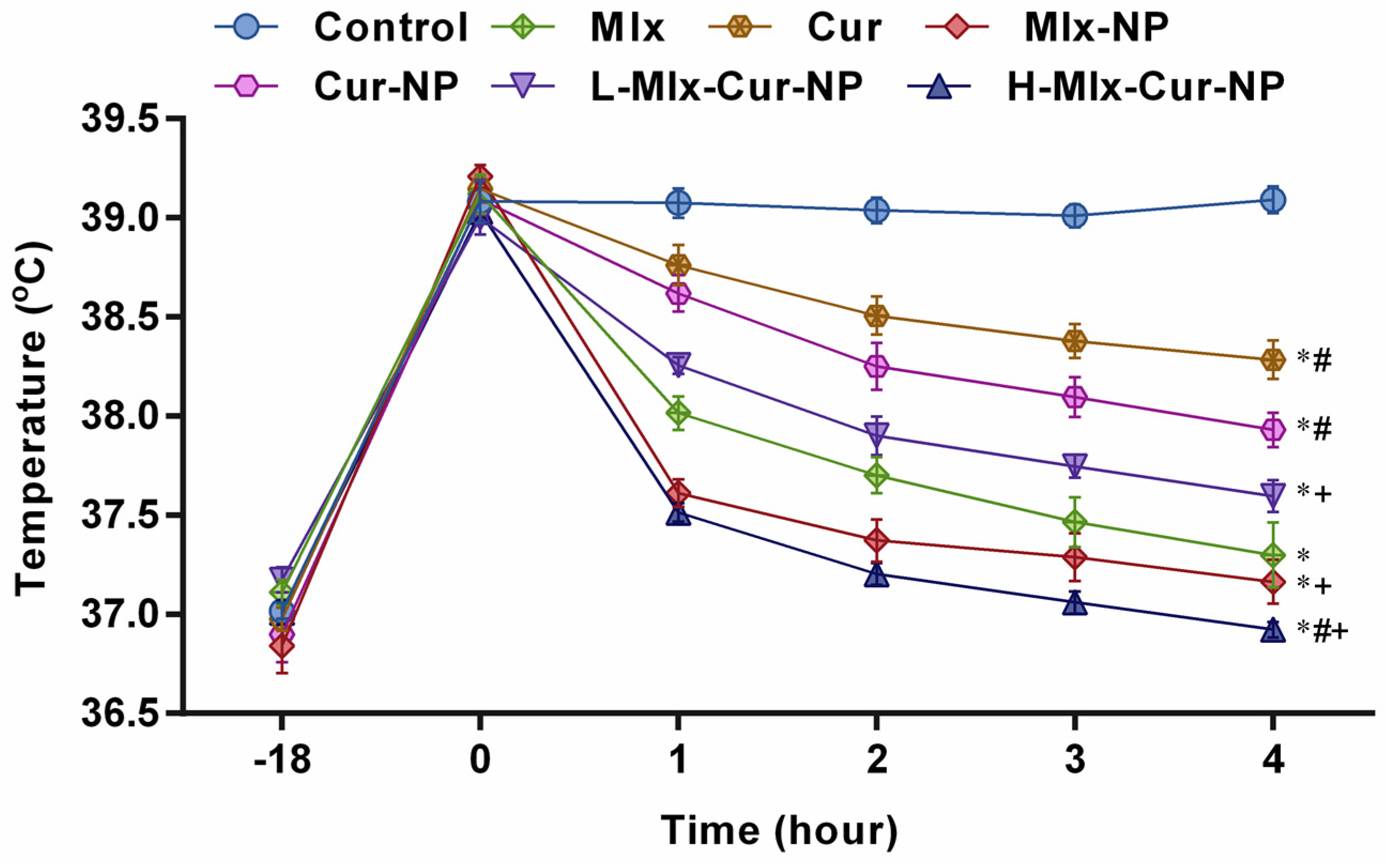


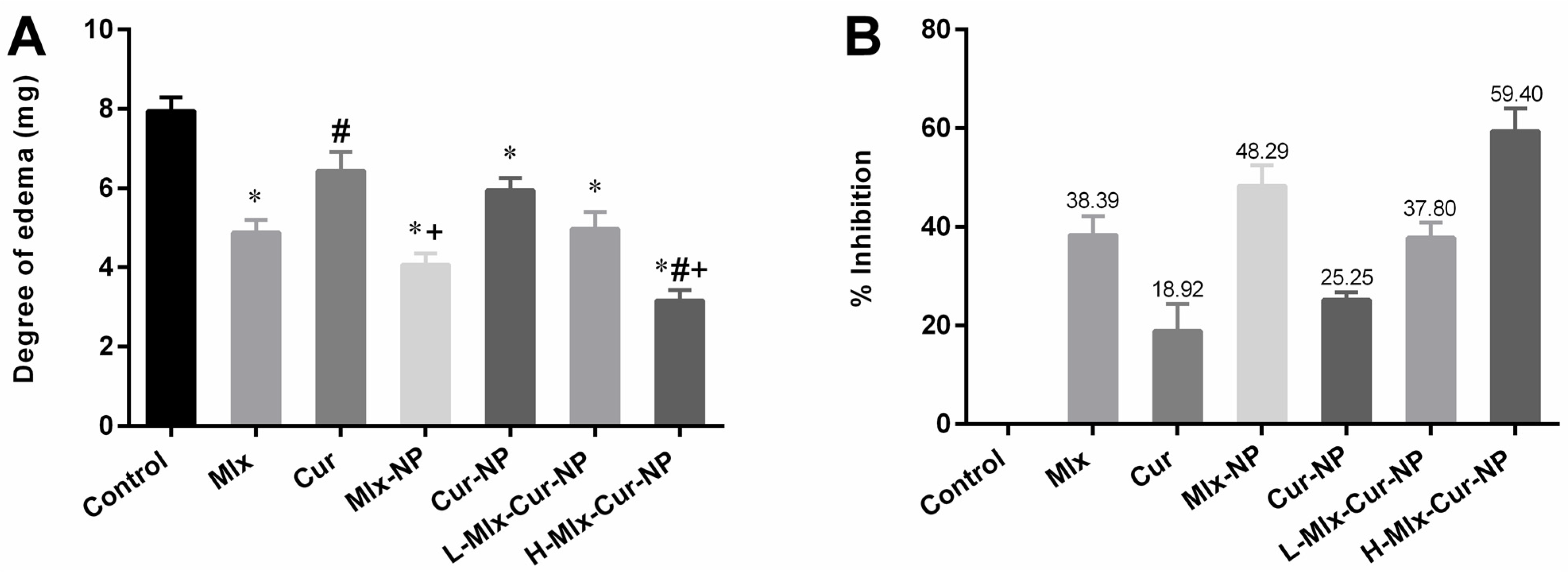

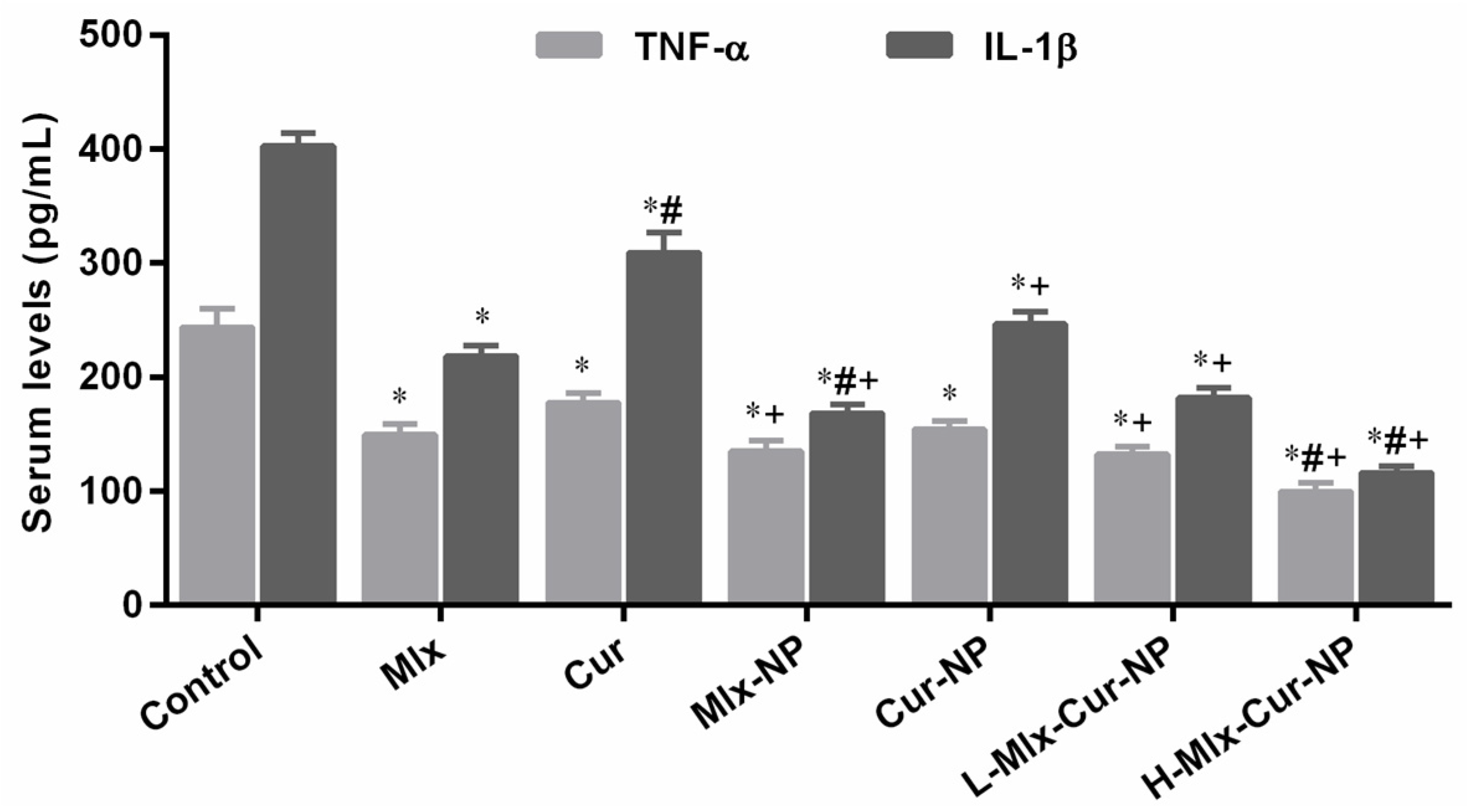
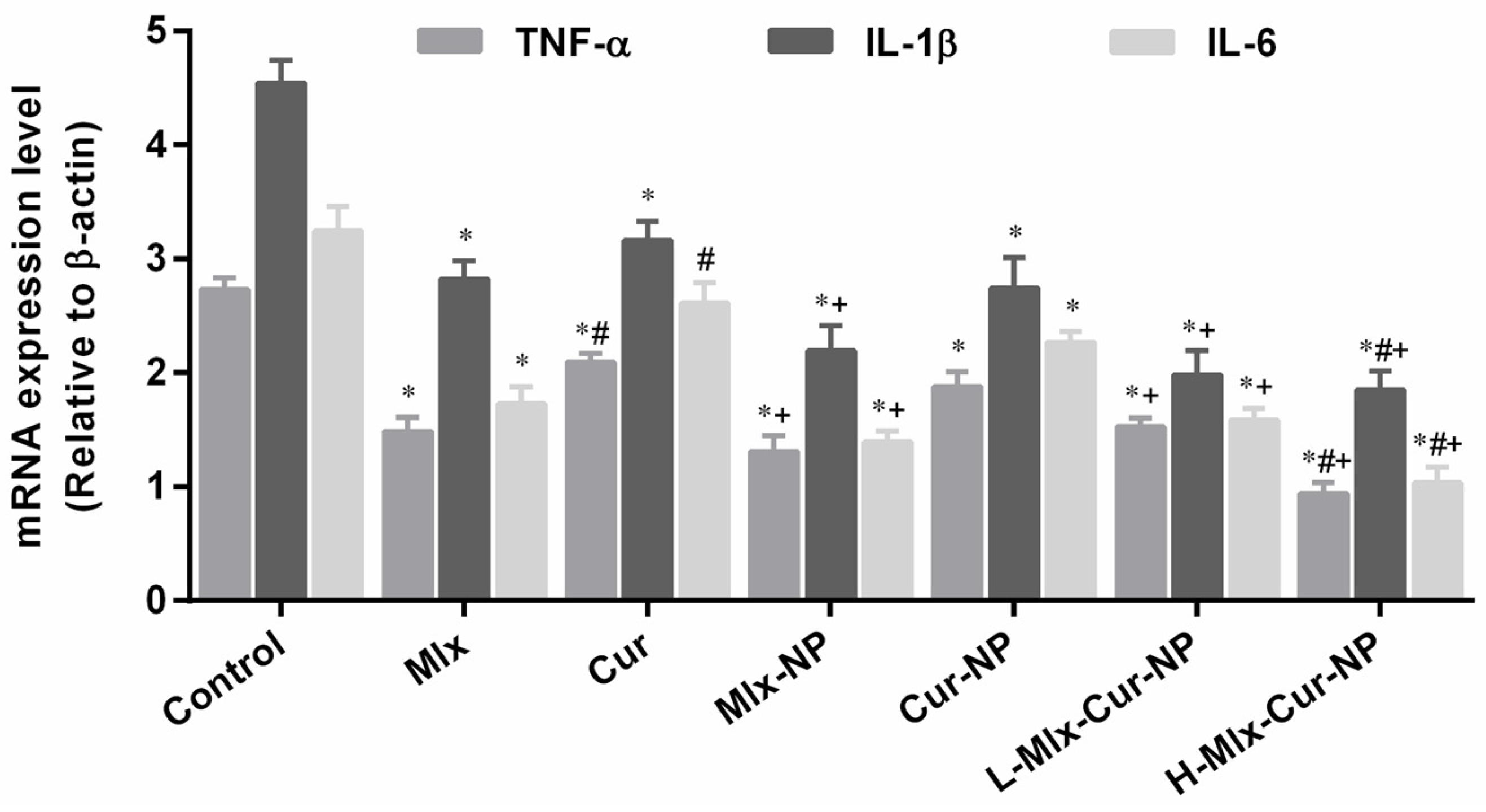
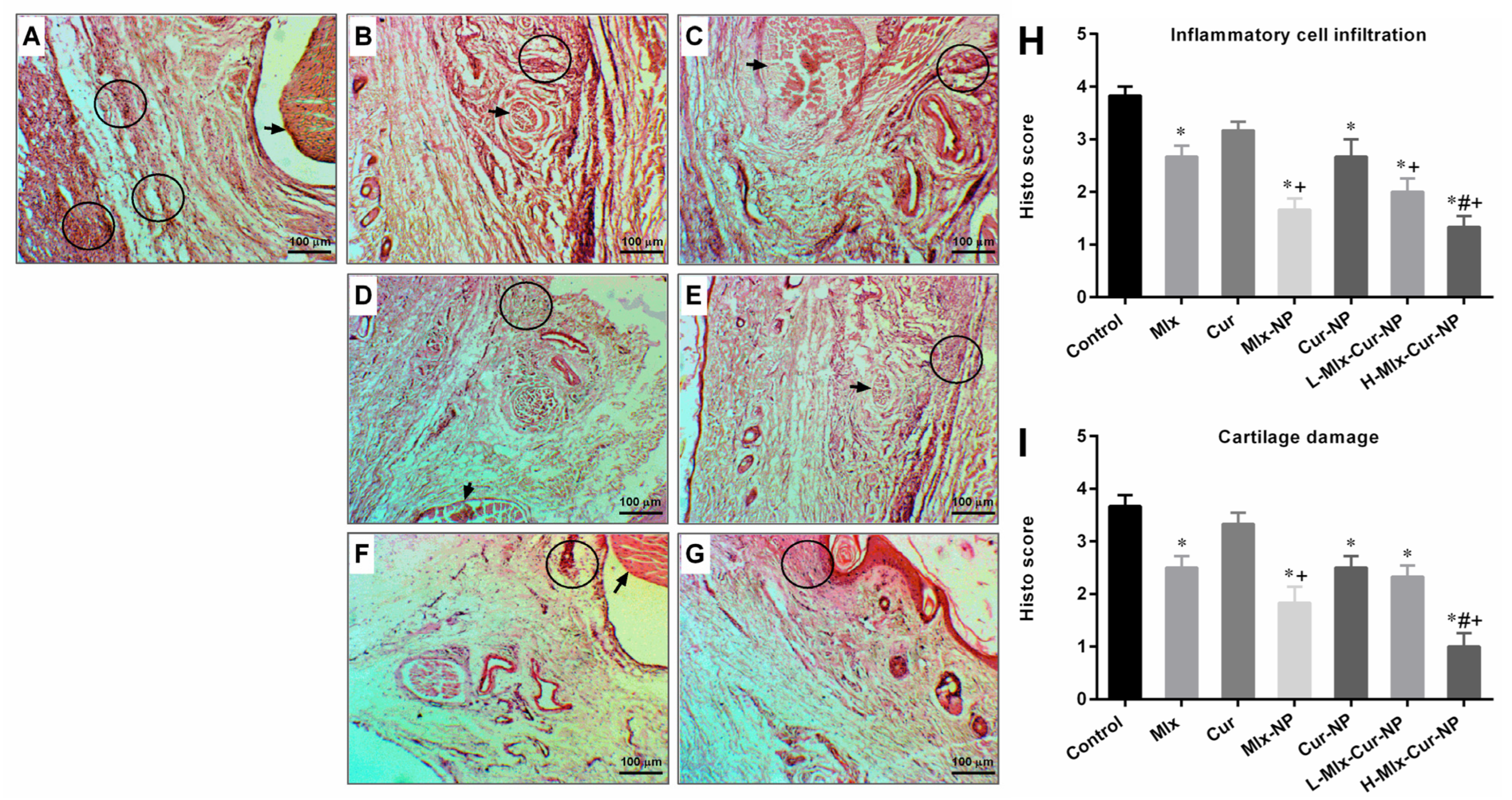
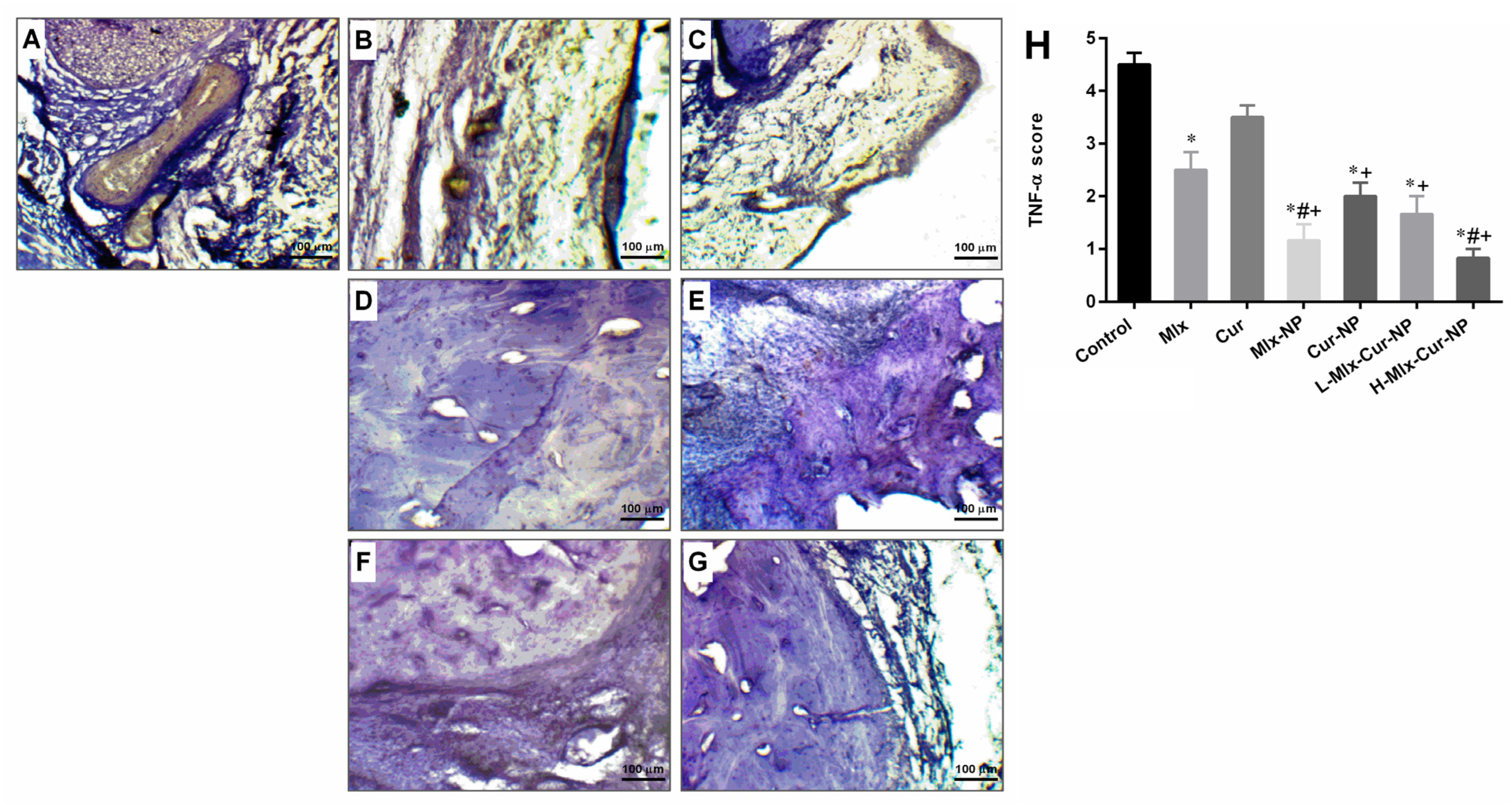
| Groups | Treatments |
|---|---|
| GI: Control | Normal saline at 3 mL/kg b.w., i.p. |
| GII: Meloxicam | Free meloxicam at 4 mg/kg b.w., i.p. |
| GIII: Curcumin | Free curcumin at 15 mg/kg b.w., i.p. |
| GIV: Mlx-NP | Meloxicam-loaded nanoparticles (4 mg/kg b.w.), i.p. |
| GV: Cur-NP | Curcumin-loaded nanoparticles (15 mg/kg b.w.), i.p. |
| GVI: L-Mlx-Cur-NP | Nanoparticles co-encapsulating meloxicam (2 mg/kg b.w.) + curcumin (7.5 mg/kg b.w.), i.p. |
| GVII: H-Mlx-Cur-NP | Nanoparticles co-encapsulating meloxicam (4 mg/kg b.w.) + curcumin (15 mg/kg b.w.), i.p. |
Disclaimer/Publisher’s Note: The statements, opinions and data contained in all publications are solely those of the individual author(s) and contributor(s) and not of MDPI and/or the editor(s). MDPI and/or the editor(s) disclaim responsibility for any injury to people or property resulting from any ideas, methods, instructions or products referred to in the content. |
© 2023 by the authors. Licensee MDPI, Basel, Switzerland. This article is an open access article distributed under the terms and conditions of the Creative Commons Attribution (CC BY) license (https://creativecommons.org/licenses/by/4.0/).
Share and Cite
Aslam, B.; Hussain, A.; Bari, M.U.; Faisal, M.N.; Sindhu, Z.u.D.; Alonaizan, R.; Al-Akeel, R.K.; Naz, S.; Khan, R.U. Anti-Pyretic, Analgesic, and Anti-Inflammatory Activities of Meloxicam and Curcumin Co-Encapsulated PLGA Nanoparticles in Acute Experimental Models. Metabolites 2023, 13, 935. https://doi.org/10.3390/metabo13080935
Aslam B, Hussain A, Bari MU, Faisal MN, Sindhu ZuD, Alonaizan R, Al-Akeel RK, Naz S, Khan RU. Anti-Pyretic, Analgesic, and Anti-Inflammatory Activities of Meloxicam and Curcumin Co-Encapsulated PLGA Nanoparticles in Acute Experimental Models. Metabolites. 2023; 13(8):935. https://doi.org/10.3390/metabo13080935
Chicago/Turabian StyleAslam, Bilal, Asif Hussain, Muhammad Usman Bari, Muhammad Naeem Faisal, Zia ud Din Sindhu, Rasha Alonaizan, Rasha K. Al-Akeel, Shabana Naz, and Rifat Ullah Khan. 2023. "Anti-Pyretic, Analgesic, and Anti-Inflammatory Activities of Meloxicam and Curcumin Co-Encapsulated PLGA Nanoparticles in Acute Experimental Models" Metabolites 13, no. 8: 935. https://doi.org/10.3390/metabo13080935
APA StyleAslam, B., Hussain, A., Bari, M. U., Faisal, M. N., Sindhu, Z. u. D., Alonaizan, R., Al-Akeel, R. K., Naz, S., & Khan, R. U. (2023). Anti-Pyretic, Analgesic, and Anti-Inflammatory Activities of Meloxicam and Curcumin Co-Encapsulated PLGA Nanoparticles in Acute Experimental Models. Metabolites, 13(8), 935. https://doi.org/10.3390/metabo13080935








